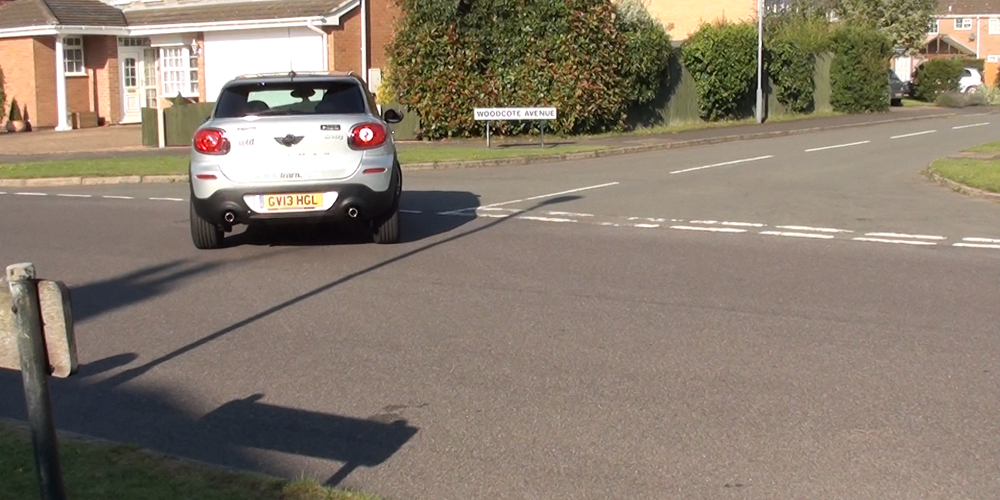
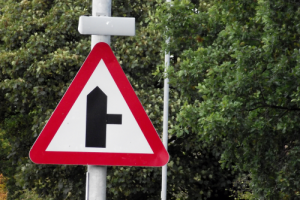 By now, you should be using the hazard routine every time you approach a junction to turn left.
By now, you should be using the hazard routine every time you approach a junction to turn left.
Good news! Turning right uses the same approach sequence.
By using your routine efficiently, you can ensure that you will always stay safe when turning right.
When turning right from a main road into a side road, you have a bit more to deal with than when turning left - there might be traffic approaching or turning out in front of you.
The is a greater accident risk at right turns - this is why they often crop up as test fail situations. Not because people crash on test (although that does happen sometimes!), but because examiners are trained to pay close attention to ensure that you will be safe at right turns after passing the test.
In this lesson, you will learn how to apply the hazard routine when turning right from a main road and revise your knowledge of turning right when emerging.
For all ten Tutorial Videos about turning right and videos lessons for lots of other subjects, see the Driving Test Success practical driving app. (Google Play | App Store - appstore practical videos available as an in app purchase in the 4 in 1 kit)
Your driving test will include several right turns. These can range from quiet turns on housing estates to turns at busy traffic light-controlled junctions. Regardless of the type of turn, your examiner will look for the same things as any other junction, a routine approach, good observation and good decision-making.
Examiners watch your right turns carefully. This is because right turns have a high accident risk. However, as long as you follow the advice in this lesson, you will keep accident free during your test and after you pass!
Your examiner will give the instruction to turn in good time. If the examiner doesn't give a route direction, and you are not in the independent driving phase of the test, you might be missing a road sign instructing you to 'turn right only' – be on the lookout for signs all the time!
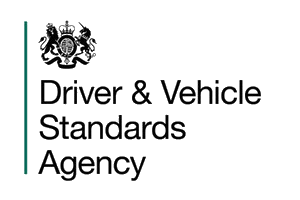
The examiner will look for:
Use of the hazard routine
Effective observation
Compliance with signs and road markings
Correct positioning before and after the junction
Dealing with other road users safely
When you see a right turn sign check your mirrors.
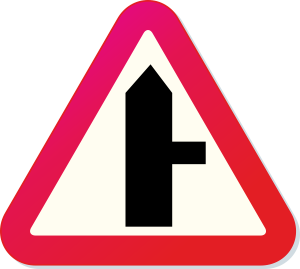
Warning - junction on the right ahead
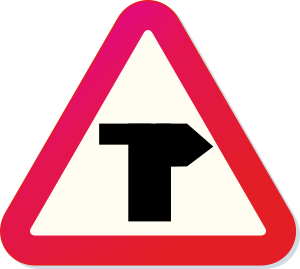
Here the main road turns right, but beware of traffic from the left who may have missed signs or markings.

Old style junction on the right sign - this style of sign has been phased out and is now very rare
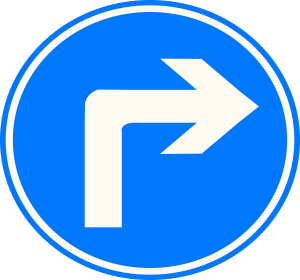
Here you have no choice, you must turn right ahead.
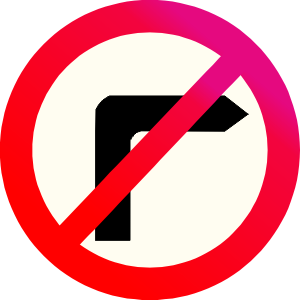
It might seem strange to include this 'no right turn' sign here, however, if you are in a strange area or on your test and your sat-nav says 'next right' it doesn't mean down this road!
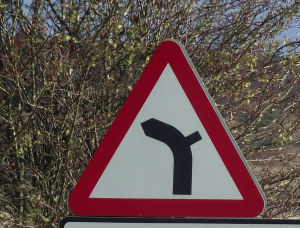
This sign warns of a junction to the right which is situated on a bend.
Not sure where in the world the two signs below are - but they are guaranteed to confuse!


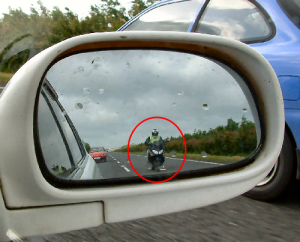
As you approach junctions to turn right, you need to check your mirrors early.
Is there anyone overtaking?
Is it safe to make the turn?
When you are satisfied that it's safe to turn, give your signal and move to a position just left of the centre line or in the appropriate lane. On a wide road, this will allow room for traffic behind to pass you on the left if they are going straight ahead.
Note: Although your normal position will be near the centre line, you must make sure you leave enough room for approaching traffic to pass. With this in mind, take special care if there are cars parked on the right-hand side of the road.
Make the same considerations about speed and gear as when turning left, but this time pay more attention to the approaching traffic.
Before you cross in front of other traffic, you have to be 100 per cent certain that you won't cause the approaching drivers/riders to change their speed or direction and that you can complete your turn safely.
The basic rule applies here: If you don't know, don't go!
If cars are approaching, you can often make the turn more quickly by slowing down a little extra on the approach.
As you slow down, you can time your arrival at the junction to coincide with a gap in the traffic - this way, you won't have to come to a complete stop.
Warning: Never speed up to try and make it into a gap; if you do this, there will not be enough time to take effective observation.
 You have read about flashing headlights in the signals section of this programme - but it's worth revising your knowledge here because flashing is a commonly used signal at right turns.
You have read about flashing headlights in the signals section of this programme - but it's worth revising your knowledge here because flashing is a commonly used signal at right turns.
If an approaching driver flashes their headlights at a right turn in the UK, it's almost always because they intend to give way to you. But flashing headlights mean the exact opposite in some countries –some drivers you meet will have passed their driving test abroad!
But although flashing headlights in the UK generally mean that the other driver intends to give way, this is not the official meaning of the signal.
Rules 110 and 111 in The Highway Code say:
'Only flash your headlights to let other road users know you are there. Do not flash your headlights to convey any other message or intimidate other road users.
Never assume that flashing headlights is a signal inviting you to proceed. Use your own judgment and proceed carefully.'
When someone flashes their headlights, ask yourself the following questions:
Am I sure that the signal is for me?
It's possible that the other driver is signalling to someone else or has spotted a friend and is saying hello. This potential confusion is why the Highway Code says you should only use flashing headlights to let others know you are there.
Is the other driver stopping or slowing?
Relying on the headlamp flash alone is very dangerous. What else is the other driver doing that would indicate that he intends to give way to you? Consider the driver's speed and position - where are they looking? Whenever possible, make brief eye contact to confirm their intentions.
Is there anyone else who might think that the signal is for them?
Although the other driver might be flashing at you, there is always a chance that someone else might think that the signal is for them. For example, if there is a car waiting to come out of the junction that you're turning into, the driver might think that it is OK to pull out - imagine what could happen if you both started moving at the same time!
If the signal is for me - is it safe to proceed?
The approaching driver is only part of the equation. Is the road that you are turning into clear? Do you need to give way to pedestrians? Is their a bicycle or motorcycle overtaking you? Never be in a hurry to proceed simply because someone is giving way - allays check for safety.
Sometimes there will be a specific lane for right-turning traffic. These can be full lanes or special 'short' right-turn lanes marked out by 'hatching' on the road surface (diagonal white lines) as shown in the diagram, which shows a hatched area bordered by broken white lines - sometimes there will be a solid white line.
You should generally avoid driving in the hatched area - the road markings keep traffic streams apart and aid visibility. However, if a broken line borders the hatched area, you can enter it if necessary to keep the traffic flowing and allow others to pass you on the left.
If the line around the hatching is solid, you must not cross it except in an emergency.
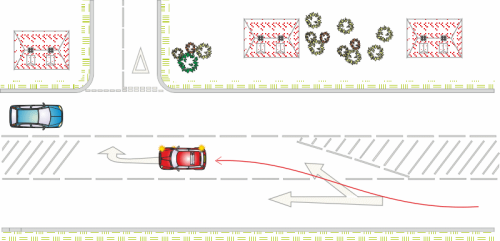
Earlier, we said that if you are unsure whether or not to proceed, you should wait.
If you need to wait, stop in position W (diagram below) until it is safe to turn; waiting in this position will enable you to steer easily – take care not to stop too far forward.
While waiting, keep your wheels pointing straight ahead and use the handbrake; this prevents you from being pushed across the road into the path of approaching traffic if someone bumps you from behind or your foot slips off the clutch in a manual car.
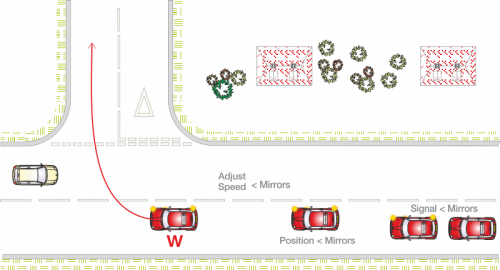
To help you decide whether to turn or wait, you can use your experience as a pedestrian.
If you could safely walk across the road in front of the approaching car on foot, there would be enough time to drive across. However, there is more to think about than the approaching traffic.
You must ensure you can complete the turn without having to stop. This means that you need to look out for pedestrians, cyclists, traffic queues in the side road, and parked vehicles or other obstructions that could prevent you from turning safely.
Good observation not only allows you to ensure that it's safe to turn, it will also help with your steering. To steer safely, you must be looking in the correct place – that is, where you want the car to go.
IMPORTANT: When you start to turn at point W (on the diagram above), look out of the driver's window into the side road, NOT the windscreen.
As you turn, your eyes will slowly move back to the windscreen to maintain your view along the road (you will do this naturally). As your eyes start to turn towards the windscreen, turn the steering wheel to straighten up, letting your hands follow your eyes.
Immediately before turning, double check that there is no one passing on your right.
Motorcyclists call this the 'lifesaver check' - they always check mirrors and blind spots before turning or changing lanes (left or right). As a car driver the right mirror and blind spot check can also be a lifesaver. Check that there are no motorcyclists, cyclists or other vehicles about to overtake you immediately before you turn right.
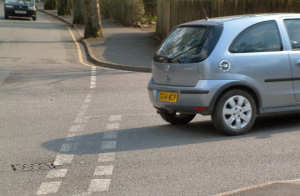
The photo shows a car 'cutting a right-hand corner'.
'Cutting the corner' describes crossing the centre white lines of the road you are turning into.
Cutting corners can be extremely dangerous. The driver in the photo was lucky on this occasion, but you can't rely on luck for safe driving; good luck and bad luck tends to come in equal measures. Perhaps next time this driver will meet someone - with a bang!
By turning too soon, you will not be able to see into the side road properly. There could be traffic approaching, children playing or any number of things that will affect the safety of your turn.
Take care to keep to your side of the road as you turn as shown by the red line on the diagram - this is essential to get a good view into the new road before entering it.
IMPORTANT: When you start to turn at point W (on the diagram above), look out of the driver's window into the side road, NOT the windscreen.

You have already read about emerging from junctions in a previous section. This is simply a little extra advice.
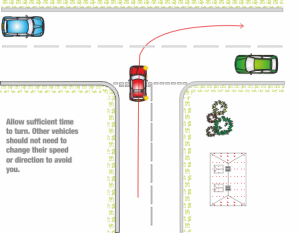
Much like emerging to the left, you must take care not to inconvenience or endanger traffic already on the main road.
This means that:
You must have enough time to cross in front of the traffic approaching from your right without causing it to slow down (the green car in the diagram).
You can accelerate away from the traffic approaching from your left (the blue car in the diagram) to match the speed of the traffic flow - you must not hold up traffic behind after you emerge.
As you steer out, you should aim to get across the road by the shortest route. The point at which you start to steer will depend on the width of the road, but be careful not to steer too soon or you will end up on the wrong side!
This slide presentation is around 15 minutes and explains step-by-step how to turn right safely avoiding common dangers associated with right turns.
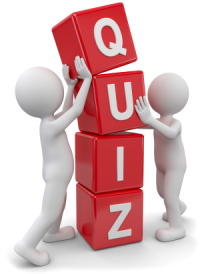 Turning Right Quiz...
Turning Right Quiz...Click here to complete the quiz for this lesson
(The page will open in a new window/tab)
You will find references for the answers in this lesson.
You can check your answers as you go along, or complete the full quiz before checking.
Leaving the check to the end is a good way to test yourself.
When you check or review your answers you will get a brief explanation of the answer.
Good Luck!